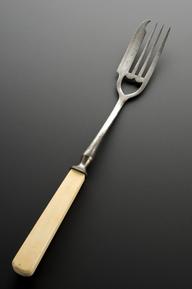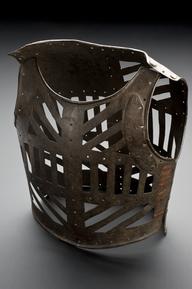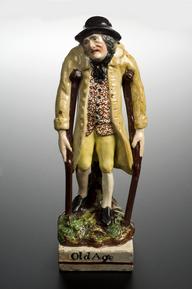





A pair of upper limb prostheses for a patient with congenital absence (amelia) of both upper limbs. He was supplied with prostheses when he was 16 years of age in 1959. These, his second pair, supplied a year later, consist of blocked leather shoulder caps joined back and front by straps and buckles. Hinged metal upper arms (permitting active abduction) also metal forearms with active elbow flexion and fully automatic elbow locks. A passive internal/external rotation device located just above each elbow. Detachable hands/terminal devices with push-rod mechanism for operating mechanical thumb or split-hook. The left (Steeplon) hand has rigid fingers and push-rod thumb. The right has three wooden articulated fingers and a semi-opposed thumb and rigid index finger. Each elbow flexion control consists of a strap attached to an anchor point, one on each side of a shaped leather waistbelt. The upper end of each strap is connected by a perlon cord to a lever-arm which pivots on the back of the respective shoulder cap. Flexion is achieved by an upward lift of the appropriate shoulder. The elbow lock control system consists of a nylon encased perlon cable (on the Bowden principle), attached to the lock lever and routed to the front of the cap on the same side. The two cables cross in front of the chest and are anchored to the waistbelt on either side of the mid-line. The lock operation is achieved by a backward thrust of the appropriate shoulder. The terminal device control also utilises a Bowden cable (wire through metal casing) routed to the outer side of each arm. The casing being anchored to respective forearms and shoulder caps with the lever system on top of each shoulder. The cables cross at the back and are fixed to the waistbelt either side of the midline. They are operated independently by a forward thrust of the appropriate shoulder. Made by Fletcher/Steeper in 1959. (Weight of limbs: 7 lbs 3.1 kg).
Made for a 17 year-old boy in 1959, this upper limb set consists of hinged metal upper arms and forearms with fully automatic rotating and locking elbows. This allows a range of movements. These are attached to blocked leather shoulder caps joined back and front by straps and buckles. The left hand has rigid fingers. The right hand has three wooden articulated fingers and a rigid index finger. This indicates the boy was right-handed. Arm movement is controlled by cables crossing the back of the body and fixed to the waist belt. A forward thrust of the appropriate shoulder locks the elbows. An upward thrust flexes the arm.
Details
- Category:
- Orthopaedics
- Object Number:
- 1999-501
- Measurements:
-
overall (torso): 320 mm x 390 mm x 180 mm, 3.1kg
overall (each arm): 610 mm
- type:
- artificial arm
- credit:
- Richmond Twickenham and Roehampton Healthcare NHS Trust




